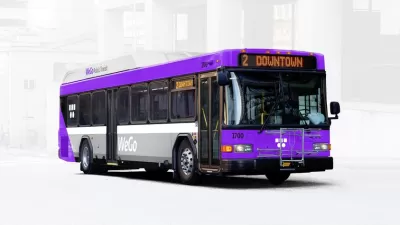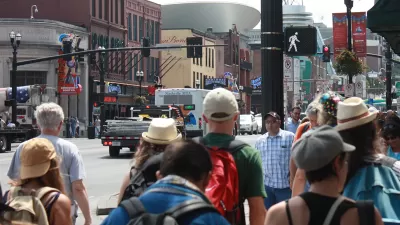The city of Nashville is trying to get back on track with some of the projects proposed in the 2016 nMotion plan—even without the massive pot of transit tax money it could have won at the ballot box.

"Metro officials hope an $18 million transit center will spark fresh activity in a part of town that has felt few ripples from Nashville's overall boom," reports Meg Garner in an article that might be blocked by a paywall for some readers.
Aaron Short provides additional, paywall-free coverage of the transit center plans, also providing background on the Let's Move Nashville transit funding referendum rejected by voters in May 2018. As noted by Short and Garner, the transit center is a part of the nMotion transit plan approved by Nashville region officials in 2016. In 2019, the transit center plans will rely on funding from the federal government.
Short describes the vision for the proposed transit center. "Once completed, the enclosed station would have up to four open-air bus bays with a climate-controlled passenger-waiting area, cyclist amenities and facilities conveying real-time locations of incoming buses, according to the MTA. Three bus routes now provide service through the location but the hub could provide connections for up to three more routes, including rapid bus services."
Short offers a lot more information on the political and planning context for the new proposal, as also recently provided by TransitCenter. Transit is tricky in Nashville—as more anecdotes than the failure of Let's Move Nashville prove. This past June, WeGo (née Nashville MTA) announced it would eliminate eight bus routes and raise fares from $1.70 to $2.

Study: Maui’s Plan to Convert Vacation Rentals to Long-Term Housing Could Cause Nearly $1 Billion Economic Loss
The plan would reduce visitor accommodation by 25,% resulting in 1,900 jobs lost.

North Texas Transit Leaders Tout Benefits of TOD for Growing Region
At a summit focused on transit-oriented development, policymakers discussed how North Texas’ expanded light rail system can serve as a tool for economic growth.

Why Should We Subsidize Public Transportation?
Many public transit agencies face financial stress due to rising costs, declining fare revenue, and declining subsidies. Transit advocates must provide a strong business case for increasing public transit funding.

How to Make US Trains Faster
Changes to boarding platforms and a switch to electric trains could improve U.S. passenger rail service without the added cost of high-speed rail.

Columbia’s Revitalized ‘Loop’ Is a Hub for Local Entrepreneurs
A focus on small businesses is helping a commercial corridor in Columbia, Missouri thrive.

Invasive Insect Threatens Minnesota’s Ash Forests
The Emerald Ash Borer is a rapidly spreading invasive pest threatening Minnesota’s ash trees, and homeowners are encouraged to plant diverse replacement species, avoid moving ash firewood, and monitor for signs of infestation.
Urban Design for Planners 1: Software Tools
This six-course series explores essential urban design concepts using open source software and equips planners with the tools they need to participate fully in the urban design process.
Planning for Universal Design
Learn the tools for implementing Universal Design in planning regulations.
Ascent Environmental
Borough of Carlisle
Institute for Housing and Urban Development Studies (IHS)
City of Grandview
Harvard GSD Executive Education
Toledo-Lucas County Plan Commissions
Salt Lake City
NYU Wagner Graduate School of Public Service





























